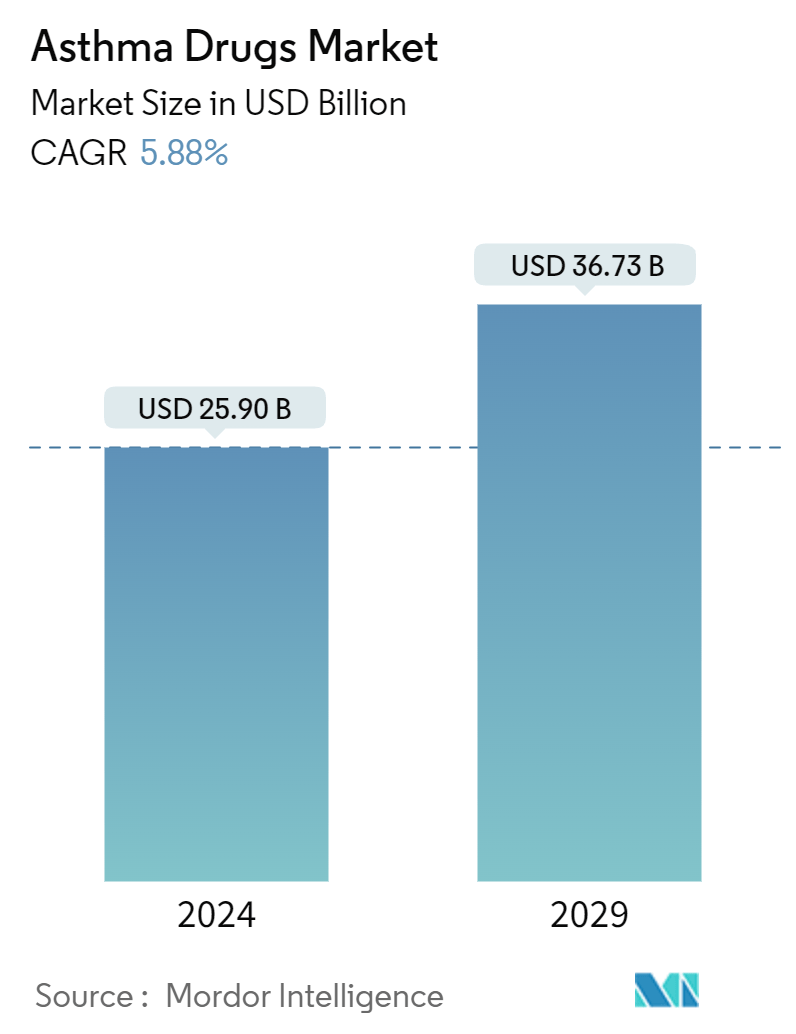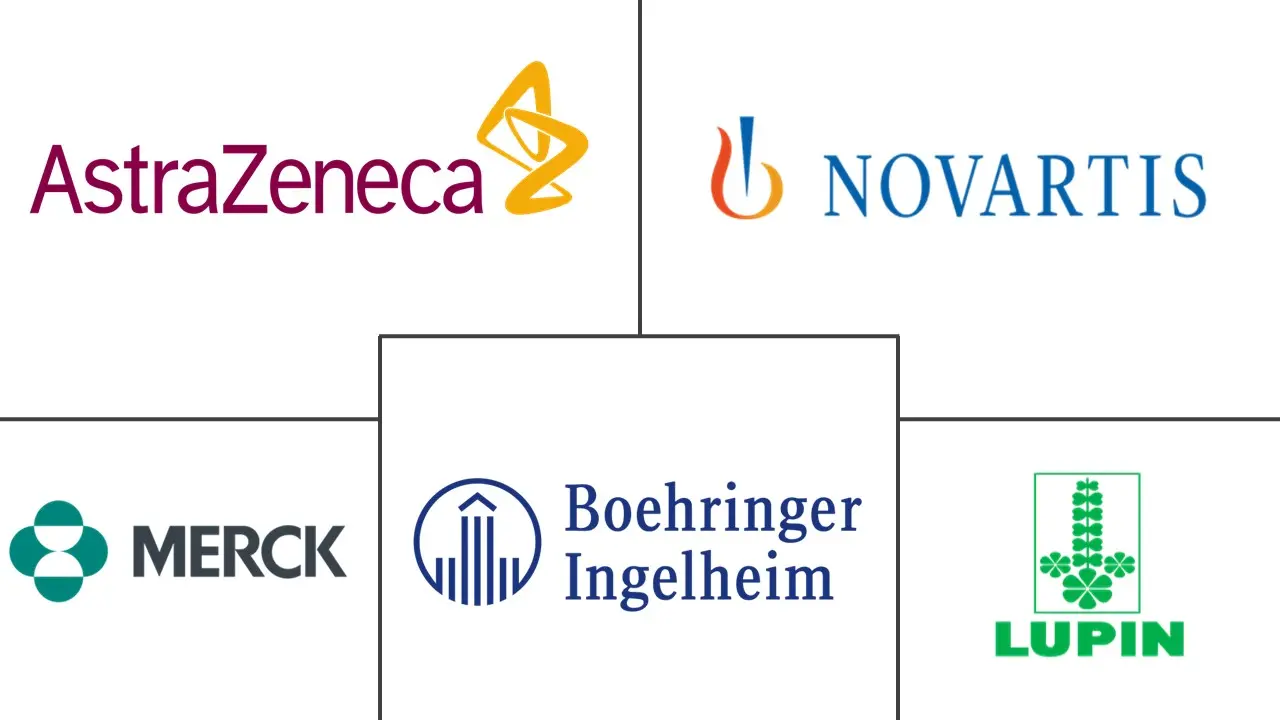Market Size of Asthma Drugs Industry

| Study Period | 2021 - 2029 |
| Market Size (2024) | USD 25.90 Billion |
| Market Size (2029) | USD 36.73 Billion |
| CAGR (2024 - 2029) | 5.88 % |
| Fastest Growing Market | Asia Pacific |
| Largest Market | North America |
| Market Concentration | Medium |
Major Players
*Disclaimer: Major Players sorted in no particular order |
Asthma Drugs Market Analysis
The Asthma Drugs Market size is estimated at USD 25.90 billion in 2024, and is expected to reach USD 36.73 billion by 2029, growing at a CAGR of 5.88% during the forecast period (2024-2029).
Factors such as an increase in the incidence and prevalence of asthma, the growing geriatric population, and technological advancements are boosting the growth of the asthma drug market.
The prevalence of asthma is increasing globally due to various reasons, such as air pollution, occupational chemicals and dust, frequent lower respiratory infections during childhood, tobacco smoking, and other environmental factors, which boost the growth of the asthma drug market. World Health Organization (WHO) included asthma in the Global Action Plan for the Prevention and Control of Noncommunicable Diseases (NCDs). As per the latest update on World Asthma Day 2023, the prevalence of asthma is increasing globally, affecting approximately 339 million people. This showed a significantly high burden of asthma globally, likely to boost the demand for asthma drugs and propel the market’s growth over the forecast period.
Rising cases of smoking worldwide are increasing the risk of asthma in people. For instance, according to an article published by BMC Pulmonary Medicine in April 2022, smoking was widely recognized as a significant risk factor for various noncommunicable diseases, notably lung cancer and chronic respiratory conditions such as asthma. The harmful chemicals in tobacco smoke can cause inflammation and damage to the respiratory system, increasing the likelihood of developing asthma or exacerbating existing symptoms. Thus, the increasing number of cases of tobacco smoking is raising the demand for asthma drugs for their treatment.
The continuous evolution of technology, particularly in the development of biomarkers, is expected to create significant opportunities for the market. The inherent limitations of conventional treatments, such as delayed therapeutic effects and reduced effectiveness, drive the market toward the innovation of new targeted therapies. This shift is anticipated to fuel market growth. For instance, in January 2023, AstraZeneca's Tezspire (tezepelumab) received a positive opinion from the Committee for Medicinal Products for Human Use (CHMP) for its use in a prefilled pen for self-administration. This approval, which allows patients with severe asthma aged 12 years and older to self-administer the drug, enhances the flexibility and convenience of treatment options.
Therefore, increasing cases of asthma and technological advancements are propelling the growth of the asthma drug market. However, stringent government regulations for product approval and side effects associated with drugs are restraining the market growth.
Asthma Drugs Industry Segmentation
As per the scope of the report, asthma is a chronic respiratory disease that blocks the airways of the lungs because of mucus production, inflammation, and muscle tightening. Asthma drugs are used to treat these respiratory diseases.
The asthma drug market is segmented by drug class and geography. By drug class, the market is segmented into bronchodilators, anti-inflammatory drugs, monoclonal antibodies, and combination drugs. The bronchodilators are further segmented into short-acting beta-2 agonists, long-acting beta-2 agonists, and anticholinergic agents. The anti-inflammatory drugs are further segmented into oral and inhaled corticosteroids, anti-leukotrienes, phosphodiesterase type-4 inhibitors, and other anti-inflammatory drugs. By geography, the market is segmented into North America, Europe, Asia-Pacific, the Middle East and Africa, and South America. The report also covers the estimated market sizes and trends for countries across major regions globally. The report offers the value (USD) for all the above segments.
| By Drug Class | ||||||
| ||||||
| ||||||
| Monoclonal Antibodies | ||||||
| Combination Drugs |
| By Geography | ||||||||
| ||||||||
| ||||||||
| ||||||||
| ||||||||
|
Asthma Drugs Market Size Summary
The asthma drugs market is poised for significant growth, driven by an increasing global prevalence of asthma and advancements in medical technology. The rising incidence of asthma is attributed to factors such as air pollution, tobacco smoking, and environmental conditions, which have led to a higher demand for effective asthma treatments. The market is further bolstered by the aging population and the inclusion of asthma in global health initiatives by organizations like the World Health Organization. Technological innovations, particularly in the development of targeted therapies and biomarkers, are expected to create new opportunities, enhancing treatment flexibility and convenience. However, the market faces challenges from stringent regulatory requirements and potential side effects associated with asthma medications.
In North America, the asthma drugs market is expected to expand due to the high prevalence of asthma, particularly among low-income and minority groups. The region benefits from a robust healthcare infrastructure, favorable reimbursement policies, and the availability of advanced treatments. The market is characterized by a moderate level of fragmentation, with major players like AstraZeneca, Boehringer Ingelheim, and Novartis actively participating in product launches and clinical trials. The introduction of new products, such as AstraZeneca's AIRSUPRA and Tezspire, along with strategic partnerships and distribution agreements, is anticipated to drive market growth. The increasing reliance on short-acting beta-2 agonists for immediate symptom relief highlights the ongoing demand for asthma medications, with generic players expected to gain market share as patents expire.
Asthma Drugs Market Size - Table of Contents
-
1. MARKET DYNAMICS
-
1.1 Market Overview
-
1.2 Market Drivers
-
1.2.1 Increase in Incidence and Prevalence of Asthma
-
1.2.2 Technological Advancements
-
1.2.3 Growing Geriatric Population
-
-
1.3 Market Restraints
-
1.3.1 Stringent Government Regulations for the Product Approval
-
1.3.2 Side Effects Associated with Drugs
-
-
1.4 Porter's Five Forces Analysis
-
1.4.1 Bargaining Power of Suppliers
-
1.4.2 Bargaining Power of Buyers/Consumers
-
1.4.3 Threat of New Entrants
-
1.4.4 Threat of Substitute Products
-
1.4.5 Intensity of Competitive Rivalry
-
-
-
2. MARKET SEGMENTATION (Market Size by Value - USD)
-
2.1 By Drug Class
-
2.1.1 Bronchodilators
-
2.1.1.1 Short-acting Beta-2 Agonists
-
2.1.1.2 Long-acting Beta-2 Agonists
-
2.1.1.3 Anticholinergic Agents
-
-
2.1.2 Anti-inflammatory Drugs
-
2.1.2.1 Oral and Inhaled Corticosteroids
-
2.1.2.2 Anti-leukotrienes
-
2.1.2.3 Phosphodiesterase Type-4 Inhibitors
-
2.1.2.4 Other Anti-inflammatory Drugs
-
-
2.1.3 Monoclonal Antibodies
-
2.1.4 Combination Drugs
-
-
2.2 By Geography
-
2.2.1 North America
-
2.2.1.1 United States
-
2.2.1.2 Canada
-
2.2.1.3 Mexico
-
-
2.2.2 Europe
-
2.2.2.1 Germany
-
2.2.2.2 United Kingdom
-
2.2.2.3 France
-
2.2.2.4 Italy
-
2.2.2.5 Spain
-
2.2.2.6 Rest of Europe
-
-
2.2.3 Asia-Pacific
-
2.2.3.1 China
-
2.2.3.2 Japan
-
2.2.3.3 India
-
2.2.3.4 Australia
-
2.2.3.5 South Korea
-
2.2.3.6 Rest of Asia-Pacific
-
-
2.2.4 Middle East and Africa
-
2.2.4.1 GCC
-
2.2.4.2 South Africa
-
2.2.4.3 Rest of Middle East and Africa
-
-
2.2.5 South America
-
2.2.5.1 Brazil
-
2.2.5.2 Argentina
-
2.2.5.3 Rest of South America
-
-
-
Asthma Drugs Market Size FAQs
How big is the Asthma Drugs Market?
The Asthma Drugs Market size is expected to reach USD 25.90 billion in 2024 and grow at a CAGR of 5.88% to reach USD 36.73 billion by 2029.
What is the current Asthma Drugs Market size?
In 2024, the Asthma Drugs Market size is expected to reach USD 25.90 billion.

